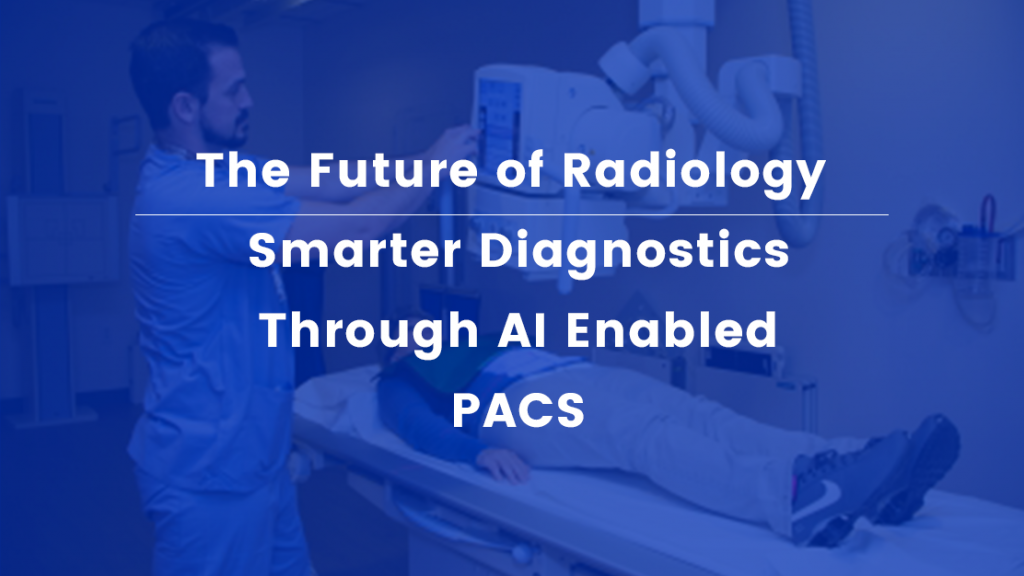The field of radiology is undergoing a revolutionary transformation fueled by rapid advancements in artificial intelligence (AI) and cloud-based computing. One of the most impactful developments in this space is the evolution of traditional Picture Archiving and Communication Systems (PACS) into intelligent, AI-integrated platforms. These modern systems are not only reshaping how imaging data is stored and accessed but also redefining how diagnoses are made—ushering in a new era of smarter, faster, and more accurate healthcare delivery.
What Is AI-Integrated PACS?
PACS has long served as the digital backbone of radiology departments, providing a centralized platform to store, retrieve, view, and share medical imaging studies such as X-rays, MRIs, and CT scans. While traditional PACS systems are effective for image management, they rely heavily on manual interpretation by radiologists. AI-integrated PACS systems take this a step further. These platforms use artificial intelligence algorithms—trained on large datasets—to analyze images automatically. They can detect abnormalities, suggest possible diagnoses, and even prioritize cases based on urgency. This AI-driven approach significantly enhances the efficiency, accuracy, and consistency of diagnostic processes.
The Core Benefits of AI-Driven PACS Solutions
1. Accelerated Diagnostic Turnaround
Time is critical in healthcare, especially in emergency and trauma cases. AI-enhanced PACS solutions can pre-analyze scans and highlight areas of concern before the radiologist reviews the case. This pre-screening allows for quicker identification of high-priority issues like strokes, tumors, or internal bleeding, enabling physicians to act swiftly and decisively. The result is faster diagnostic turnaround and improved patient outcomes.
2. Improved Diagnostic Accuracy
Artificial intelligence models are trained using vast volumes of imaging data, including thousands of annotated examples of both normal and abnormal cases. This extensive training allows the system to detect subtle anomalies that could be overlooked in a busy clinical environment. By providing a second layer of analysis, AI helps radiologists reduce oversight errors, leading to more accurate diagnoses and fewer missed conditions.
3. Enhanced Workflow Efficiency
Radiology departments often face high caseloads, repetitive tasks, and mounting pressure to deliver results quickly. AI-integrated PACS can automate time-consuming processes such as:
- Image labeling and annotations
- Measurement of lesions or structures
- Sort and categorise cases based on severity
- Generating structured reports based on findings
These automated features streamline the workflow, allowing radiologists to handle more cases in less time—without compromising quality or focus.
4. Smart Case Prioritization
One of the most impactful features of AI in PACS is intelligent triage. The system can automatically evaluate the urgency of each case and organize them accordingly in the worklist. For instance, a chest CT showing signs of a pulmonary embolism would be flagged and moved to the top of the queue, ensuring immediate attention. This dynamic prioritization enhances clinical decision-making and ensures that critical cases are not delayed.
5. Data-Driven Decision Support
Modern AI-PACS platforms are more than just diagnostic tools—they serve as decision support systems. They can compare current imaging findings with historical records, offer predictive insights, and even suggest follow-up procedures. This assists radiologists and referring physicians in making informed decisions that are backed by data, rather than relying solely on intuition or manual comparisons.
6. Seamless Integration with Cloud and HIS/RIS
Today’s AI-enabled PACS solutions are built for interoperability. They can be integrated with Hospital Information Systems (HIS), Radiology Information Systems (RIS), and Electronic Health Records (EHRs), ensuring smooth data flow across departments. Cloud-based PACS systems also offer advantages such as:
- Remote accessibility for tele-radiology
- Scalable storage
- Secure data backup
- Real-time collaboration between specialists
These features not only improve accessibility but also support a more collaborative and holistic approach to patient care.
Challenges and Considerations
While the benefits of AI-integrated PACS are substantial, there are still challenges to address. These include:
- Regulatory compliance: Ensuring that AI tools meet FDA or CE certification standards.
- Data privacy: Maintaining strict protection of patient information, especially in cloud-based systems.
- Radiologist trust: Gaining the confidence of healthcare professionals in adopting AI as a support tool, not a replacement.
- Cost and infrastructure: Initial setup and training may require investment and organizational change.
As these systems mature and become more widely adopted, ongoing education and training will be essential to maximise their impact in clinical settings.
A Glimpse Into the Future
The integration of artificial intelligence into PACS is just the beginning. Future advancements may include:
- Predictive diagnostics using AI to forecast disease progression
- Real-time collaboration between global radiologists through cloud-based platforms
- Personalised medicine, where imaging insights are tailored to a patient’s genetic and medical profile
- AI-driven radiology assistants that handle administrative tasks and patient communication
These innovations promise to not only improve radiology as a practice but also redefine the entire patient experience.
Conclusion
AI-integrated PACS is revolutionizing the field of radiology by combining the power of automation with the expertise of human clinicians. From faster diagnosis to smarter case management, it enhances every aspect of the imaging process. While challenges exist, the advantages clearly outweigh the barriers—ushering in a future where radiologists are empowered, not replaced, by intelligent tools. In this AI-powered future, radiology will not just be about viewing images—it will be about unlocking insights, saving lives, and delivering healthcare at a pace and precision the world has never seen before.
